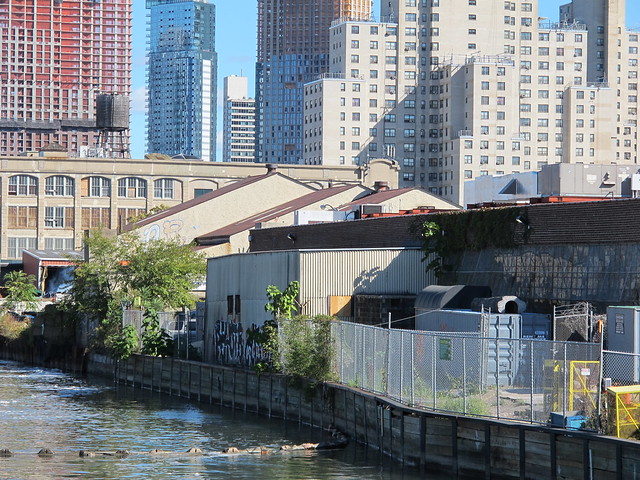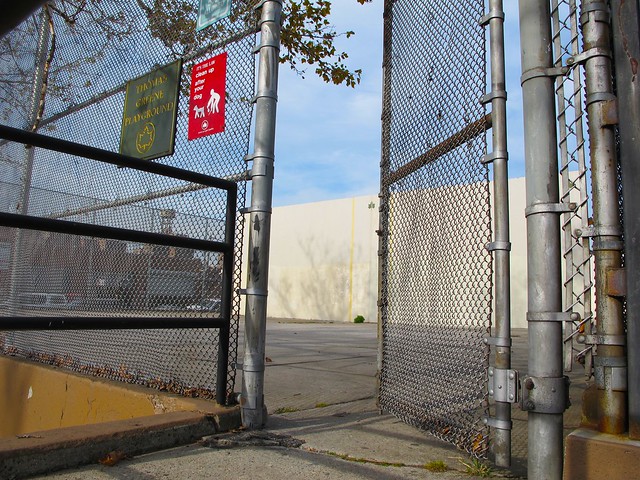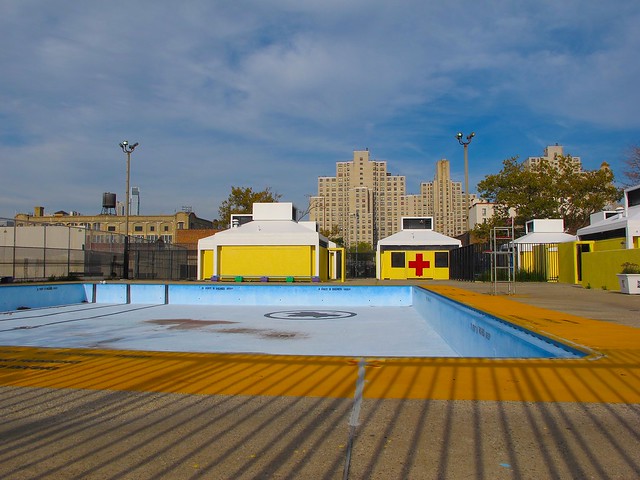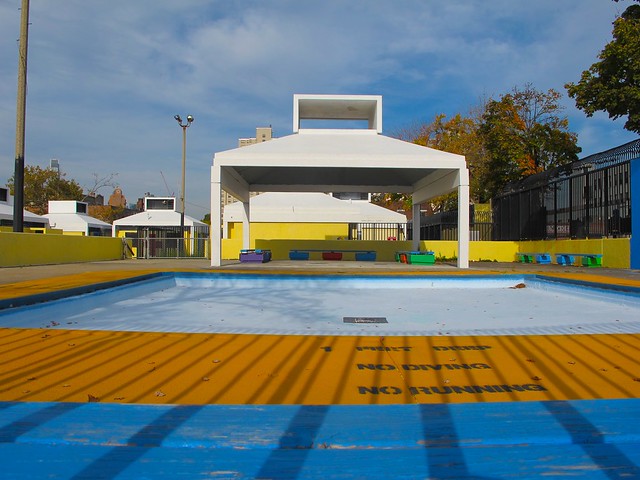(photo credit: Google map)
Handball court near Nevins Street at Douglass Greene Park

1928 photo of the former MGP site at Douglass Street, where Thomas Greene Park is now
The park, surrounded by industry, as seen from 4th Avenue
looking towards the Gowanus Canal in the 1930s.
It seems ironic that the recent Gowanus Canal Swim by clean water activist Christopher Swain to call for an accelerated, comprehensive cleanup of one of the most polluted waterways in America may coincide with a possible delay of the US Environmental Protection Agency Superfund remediation of the canal by four to five years if the City of New York gets its way.
It all has to do with the siting of the larger of two Combined Sewer Overflow (CSO) retention tanks that the US Environmental Protection Agency has ordered the New York City Department Of Environmental Protection (DEP) to construct in order to capture storm water and sewage currently being discharged into the canal and to protect EPA's Superfund remedy for the canal.
The EPA's Region 2, responsible for overseeing the Superfund clean-up, has suggested placing a 8-million gallon tank underneath the Double D pool at Thomas Greene Park because the site is already owned by the City, which would save the cost of acquiring land. In addition, the park sits on top of the former Brooklyn Union Gas Fulton Municipal Manufactured Gas Plant (MGP) which was in operation at this location from 1879 to the early 1930s. Since coal tar is currently oozing under the pool area and flows towards the Gowanus Canal, National Grid, the party responsible for the environmental clean-up, will likely be asked by EPA to dig up the pool so that the source contamination can be removed.
In would obviously make sense for National Grid and DEP to work in tandem, which would save money and time. EPA has, on a number of occasions, expressed its commitment to make sure that the PRPs (potentially responsible parties) will have to provide the community with an interim offsite pool facility during that period, and is committed to making sure that it be replaced after construction is completed.
The DEP, on the other hand, would prefer to site the 8-million gallon tank on privately owned land along the canal, adjacent to the park. To do so, the City is willing to make use of Eminent Domain if the private owners are unwilling to sell. The necessary legal proceedings involved in making this happen will take time and millions of dollars.
The City wants to place the tank at that particular location partly because of the proximity to the rest of its Gowanus infrastructure at the head of the canal, and partly to "protect the park" since the nearby community is underserved when it comes to open space and recreational facilities.
At a public meeting in May, 2015, New York City Department Of Environmental Protection Commissioner Emily Lloyd told the community: "We and the Parks Department are extremely concerned and very reluctant to lose that piece of parkland."
In addition to a tank, Commissioner Lloyd spoke of the need for a surface building (or head house) to manage "all the mechanics." She added: "If the tank were constructed at Thomas Greene Park, this head house would cover significant portions of the park."
The DEP claims that the head house would represent a 20% permanent loss of park space.
The EPA has expressed "serious concerns about the thoroughness of NYC’s analysis of the issues" and suggested that the taking of public land represents a much longer and complicated process than the City is willing to admit. At a recent EPA Gowanus Canal Community Advisory Committee meeting, the Federal Agency projected that the taking of land would delay the environmental remediation of the canal by four to five years.
It is entirely possible that the City is trying by any means possible to slow down the clean-up. How else can one explain its willingness to unnecessarily spend millions to acquire land by eminent domain when an absolutely reasonable alternative exists? But as we all know, delaying has worked for the City in the past. Why else do you think the canal has been toxic for so many decades?
The EPA has stated that it will ultimately have the final say on where the 8-million gallon tank will be sited. Judith Enck, Administrator for EPA Region 2 has insisted that a timely clean-up and keeping to the promised schedule are key factors in her decision.
The EPA will attend Community Board 6's Environmental Protection Committee meeting on October 26th at 6:30, at P.S. 32, 317 Hoyt Street
Recently, as PMFA learned, State Senator Chuck Schumer's office has called to ask EPA Region 2 for certain clarifications regarding "retention tank location in the upper Canal", in particular pertaining to the acquisition of land by eminent domain and to Thomas Greene Park.
It is probably nothing, but one sincerely hopes that Schumer's office is not trying to influence Enck's decision on this matter.
Ultimately, one can expect Administrator Enck to stay true to the principals of the EPA and to reach a final determination based solely on science and on engineering.
The EPA will attend Community Board 6's Environmental Protection Committee meeting on October 26th at 6:30, at P.S. 32, 317 Hoyt Street
Perhaps by then, Administrator Enck will have reached a decision.
Below, please find EPA's response to the inquiry by State Senator Chuck Schumer's office, which PMFA obtained under the Freedom of Information Law.
To Nicholas Martin,
Director of Policy and Economic Development Office of Senator Charles E. Schumer
NYC has made several arguments regarding the location of the tanks, both technical and legal, and we have reviewed all of their submittals and presentations EPA’s technical and legal teams still have serious concerns about the thoroughness of NYC’s analysis of the issues.
On the technical side, for example, EPA has commented on the inappropriate evaluation of the two candidate sites but NYC has not yet formally addressed EPA’s comments. In addition, following the Unilateral Order, EPA expected NYC to submit by June 30, 2015, the Preliminary Design (PD) for both tank locations that were being evaluated. To date, NYC has only submitted the PD for only one location (the one adjacent to the canal). It is our understanding that NYC will be submitting the PD for the second location in the next 5-6 weeks. In addition, NYC has not submitted several technical items required by the Unilateral Order for our review. Finally, regarding the groundwater modeling referred to in the senator’s office e-mail, we have not been provided with the details of the modeling analysis. We will request it and review it.
On the legal analysis (in particular on issues of acquisition and exercise of eminent domain) by NYC, EPA’s research, including conversations with NYC counsel, points to a much longer and complicated process than described in the points made by NYC and included in the senator’s office e-mail. EPA’s legal team has requested a meeting with NYC’s legal team to further discuss the issue. NYC has yet to respond to the request for the meeting.
Finally, regarding the impacts on the Thomas Greene Park, EPA differs with NYC both on the schedule (and the associated closure of the park) and the 20% alienation of the park as a result of an above ground operational facility for the tank.
With regard the schedule, EPA believes that the park could be cleaned up within a one-year period. Immediately following the park cleanup, the tank could be constructed in the excavated area within 3 years, based on the experience for the construction of similar size storage tanks. That amounts to a 4-year park cleanup and tank construction period compared to 8-10 year period assumed by NYC in its points.
As for the alienation of 20% of land at the park, EPA believes that the operational facility included in NYC’s presentations and in the preliminary plans is much bigger than required because certain equipment (such as screens) could be part of the nearby outfall infrastructure at the top of the canal. Alternately, the smaller operational facility could be placed at an adjacent property that could be acquired at a fraction of the acquisition costs for the properties proposed by NYC for the location of the tank. In another variation, as shown in the recent international architectural competition Gowanus by Design, the operational facility could be designed in a way so as to become an extension of the park, therefore resulting in no park land alienation at all.
Christos Tsiamis Senior Project Manager
Director of Policy and Economic Development Office of Senator Charles E. Schumer
NYC has made several arguments regarding the location of the tanks, both technical and legal, and we have reviewed all of their submittals and presentations EPA’s technical and legal teams still have serious concerns about the thoroughness of NYC’s analysis of the issues.
On the technical side, for example, EPA has commented on the inappropriate evaluation of the two candidate sites but NYC has not yet formally addressed EPA’s comments. In addition, following the Unilateral Order, EPA expected NYC to submit by June 30, 2015, the Preliminary Design (PD) for both tank locations that were being evaluated. To date, NYC has only submitted the PD for only one location (the one adjacent to the canal). It is our understanding that NYC will be submitting the PD for the second location in the next 5-6 weeks. In addition, NYC has not submitted several technical items required by the Unilateral Order for our review. Finally, regarding the groundwater modeling referred to in the senator’s office e-mail, we have not been provided with the details of the modeling analysis. We will request it and review it.
On the legal analysis (in particular on issues of acquisition and exercise of eminent domain) by NYC, EPA’s research, including conversations with NYC counsel, points to a much longer and complicated process than described in the points made by NYC and included in the senator’s office e-mail. EPA’s legal team has requested a meeting with NYC’s legal team to further discuss the issue. NYC has yet to respond to the request for the meeting.
Finally, regarding the impacts on the Thomas Greene Park, EPA differs with NYC both on the schedule (and the associated closure of the park) and the 20% alienation of the park as a result of an above ground operational facility for the tank.
With regard the schedule, EPA believes that the park could be cleaned up within a one-year period. Immediately following the park cleanup, the tank could be constructed in the excavated area within 3 years, based on the experience for the construction of similar size storage tanks. That amounts to a 4-year park cleanup and tank construction period compared to 8-10 year period assumed by NYC in its points.
As for the alienation of 20% of land at the park, EPA believes that the operational facility included in NYC’s presentations and in the preliminary plans is much bigger than required because certain equipment (such as screens) could be part of the nearby outfall infrastructure at the top of the canal. Alternately, the smaller operational facility could be placed at an adjacent property that could be acquired at a fraction of the acquisition costs for the properties proposed by NYC for the location of the tank. In another variation, as shown in the recent international architectural competition Gowanus by Design, the operational facility could be designed in a way so as to become an extension of the park, therefore resulting in no park land alienation at all.
Christos Tsiamis Senior Project Manager














.JPG)

8 comments:
Why not just use the end of the canal - shorten it by one or two blocks - and it would accomplish cleaning it up and not having to demolish or move anything? Remediation of the other sites are going to take time, and doing it this way would mean it could move in parallel instead of having to wait for land acquisition, demolition, and remediation. The city would have the tanks much closer, and they could put some parkland on top.
Public Place would be an ideal location for much needed park/recreational space.
I trust the EPA will stand firm behind their recommendations anything less will end up hurting the neighborhood in the long run. It is better to over engineer especially when future development is factored in. Let the engineers do their jobs.
As for eminent domain, has anyone spoken to the property owner. As a citizen I find it absolutely chilling that representatives of city agencies and local not for profits can be so cavalier discussing eminent domain without informing the property owner. It is irresponsible.
That toxic plume under the pool/park is not only migrating to the canal, it is also migrating towards areas where people are living. It needs to be dug up, removed, which means the pool needs to be dug up regardless.
I don't think the end of the canal (which I assume you mean near the pump house on Butler) can work. There was a study that identified a number of sites a few years ago -- the sites need to be structured to capture water flow heading into the canal, so places like the DD park or the proposed property closer to the canal. Just filling in the head of the canal seems unlikely to accomplish that. Plus you would have to re-site the pump house.
Personally, I have to disagree with the opposition to the ED proposal. I support the taking of the land (at fair market value, of course) -- it allows both for easier siting of the underground tanks, construction of any above ground structures without taking away existing parkland, and at least facilitates the availability of public access to the waterway in the first place. Unless the clean up for the old BUGS site is going to be covered by the same plan and pot of money, I don't see how trying to dual track that with the stormwater overflow project helps things. It seems to me that trying to do both will mean a longer period of time in which the park is not publicly usable.
The EPA and the pols need to act in the best interest of the community as a whole and not cave to the wishes of a vocal few. I think the community would also be better served by deferring to the expertise of the engineers. People are inconvenienced by projects all the time. My understanding is that any loss of the use of the park will be mitigated. The EPA and our electeds need to do the right thing.
It really does comes down to what can be done under the most optimum time line and provides the best engineered structure to preform the intended function.
Lets hope the EPA will hold up those ideals as the basics of their decision making and not grant leeway to any party, especially a responsible party, unless they know for certain that the responsible party is actually proposing to to carry out the best of all possible proposals.
But should the EPA grant the DEP their proposed site, the city needs to step up and not only take full responsibility for use of Eminent Domain, but also the actual performance of their facility as it sits in the land.
10:44 - fair market value, in Gowanus? Are you kidding??? Who gets to determine THAT? Eminent domain historically does not give "fair market value." There is SO much speculation going on here. Why should the owners of that property be disadvantaged? Time consuming lawsuits coming up! The EPA had an elegant solution that addressed the need to clean up the migrating toxic plume under the pool and build a retention tank, on land already owned by the city. The EPA has been working at breakneck speed to clean the canal. The tactics initiated by the Fifth Avenue Committee (in the name of people needing parks etc) are a real monkey wrench in the momentum that the EPA has built up.
BTW, that same Fifth Avenue Committee thinks it has Public Place site sewn up, also - but this time their story is the need for affordable housing. That land, which is designated for the public, for park use, playgrounds, sports fields - well, the FAC wants to build housing and put dense population along its polluted banks, with a little lip service to park/playgrounds. Hmmm....
And in the end what happend with the swimming pool ?
Post a Comment